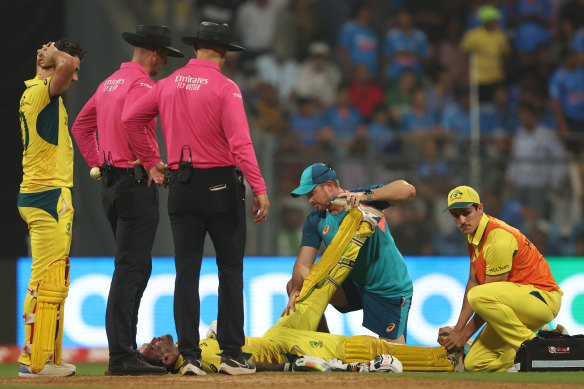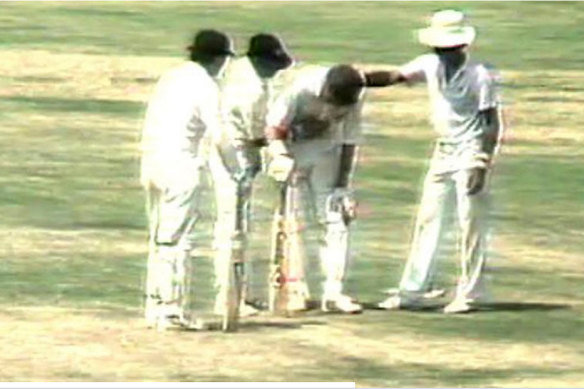Save articles for later
Add articles to your saved list and come back to them any time.
Glenn Maxwell was on 147 not out when he dropped his bat, collapsed on the pitch of Mumbai’s Wankhede Stadium, clutched at his shin and fell flat on his back.
The strange contortions in Maxwell’s body were familiar to anyone who has suffered from debilitating muscle cramps, and will become part of the legend of his astonishing double century in Tuesday night’s World Cup match against Afghanistan.
The cramp started in one of Maxwell’s toes, then moved to his shin, then took hold of his calf muscle.
“So I was cramping both sides of my lower leg. And as I went, ‘oh no, I’m cramping’, I cramped in my left hamstring at the same time,” the 35-year-old recounted. “And then I had a back spasm when I hit the ground. So I was just like, full body in pain.”
What was happening inside Maxwell’s body to cause such agony is not fully understood, according to Eric Drinkwater, a senior lecturer in sports science at Deakin University.
But the first theory is related to dehydration. Muscles require a balance of water and electrolytes. If someone drinks too much water, it dilutes the electrolytes.
“If you dilute all the electrolytes, for some reason the muscle gets stuck in this contraction. It can contract, but it can’t relax again,” Drinkwater said.
Glenn Maxwell is treated by Australian physiotherapist Ben Jones and 12th man Sean Abbott after collapsing with cramp.Credit: Getty
“Sometimes athletes can get caught up on the dehydration thing, so what happens is they drink so much plain water they end up depleting the salt.”
Experts also know that cramps tend to occur more frequently in hot temperatures.
Because sweat evaporates more slowly in humid temperatures, the body produces more sweat to cool itself down. This can result in a greater loss of fluids and electrolytes.
The temperature in Mumbai sat in the low thirties on Tuesday evening, while the humidity remained between 40 and 50 per cent throughout the night. Commentators said it was the hottest day of the tournament.
AFLW player Libby Birch, who is also a physiotherapist, explained that the contraction caused by the loss of electrolytes can be excruciating, “like being shot in the leg”.
“The essence of a cramp is your body telling you that you need to stop. It’s crying out, saying ’stop, stop, stop. I’m finished,” Birch said.
“Which is why Glenn Maxwell’s performance was so amazing.”
“What happens is the muscle can’t function as accurately and precisely, so it reacts with spasmodic cramps. It can last between seconds and minutes,” she explained.
But, as Drinkwater added, if dehydration was the sole cause of cramping, prevention would be simple: “I can’t imagine that Cricket Australia can’t get their hands on a bottle of Gatorade.”
“There has to be another explanation. That’s why there’s a second theory. That second theory goes that there’s a reflex that goes from your spinal cord to your muscle. It contracts the muscle to support your body,” he said.
Any time you take a step, hit a ball or run, that reflex is “turned on”. So if, like Maxwell, you’re doing those actions over and over again, the reflex is turning on and off. That repetition can cause fatigue, which can result in the reflex getting stuck in the “on” position.
Maxwell received treatment from the Cricket Australia physio, Ben Jones, who lifted his left leg while 12th man Sean Abbott pushed his right foot in an effort to stretch his muscles and ease the cramp. He calmed his breathing and resumed his innings, finishing undefeated on 201 from 128 deliveries, sealing Australia’s victory and a spot in the semi-finals with 19 balls remaining.
Jones’ double century in the sweltering Indian heat has gone down in history as one of the most courageous of all time.Credit: Cricket.com.au
He is not the first athlete to be struck down by cramps. The late Dean Jones was racked by cramps on his way to a famous double century in the 1986 tied Test in Chennai, but that was just one of his problems as his body effectively shut down. David Warner retired hurt on 200 after he seized up while celebrating the milestone during last year’s Boxing Day Test.
In June, men’s tennis No.1 Carlos Alcaraz said the cramps that afflicted him during his Roland Garros semi-final loss to Novak Djokovic were a result of intense tension and nerves.
Despite the frequency of muscle cramps among athletes, there is no universal cure. While many sportspeople swear by pickle juice, there’s no guarantee it will work for everyone.
Drinkwater said some people are more susceptible to cramps than others, and studying the cause is difficult because of how inconsistently they occur among athletes. Even the conditions in which they happen aren’t uniform – skiers, for example, often suffer with cramps even though it’s cold.
Maxwell soldiered on, even though he had limited use of his legs.
Abandoning footwork, he stood deep in the crease and relied on his supreme hand-eye coordination to clear the boundary.
“He can’t move and still manages to hit a six over the third man with the reverse [sweep] – he’s a freak,” captain Pat Cummins marvelled.
Birch believes the cramps may even have helped Maxwell.
“When everything’s against you in sport, sometimes it can be a relief. It’s almost like ‘nothing can get any worse than this.’ It releases you.”
Maxwell explained that he stripped the game back to its basics. “Once we stayed at the same end for a couple overs (without running), I felt like I was starting to get a little bit of movement back,” he said. “But that actually probably made the whole job a little bit more simple. I wasn’t overthinking the situation. I just knew if I got a ball that I could hit I’d try and hit it.”
Most Viewed in Sport
From our partners
Source: Read Full Article

